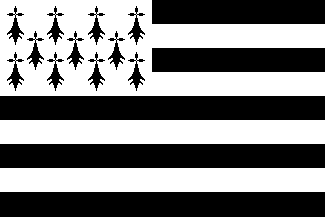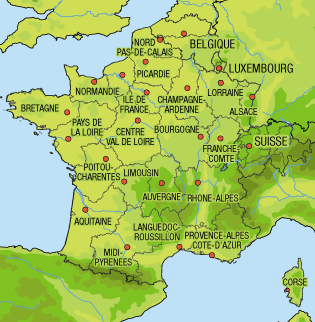

|
Free Machine Translation
|
|

|
58-50 B.C. 450-461 A.D. 6th to 9th C. 786 / 799 Early 9th C. 841 846 848 851 857 868 875 888 10th C. 992 1066 1086 1158 1182 1341-1364 1346-1459 1488 1499 1532 1534 1561 1588 1631 1664 1675 1683 1790 1791 1793-1804 1801 1801 1940-1945 1972 1985 1999 |
Roman Conquest of the Bretagne, then called Aremorica Evidence for the immigration of the Bretons (christian Britons, evading Anglo-Saxon pressure) The Bretagne split into several principalities Charlemagne subdued the Bretagne, establishment of the Breton March Unification of the Bretagne Revolt of Nominoe, hitherto a Carolingian vassall West Frankish King recognized independence of the Bretagne Dol (Bretagne) elevated to Archdiocesis; Nominoe crowned King Nominoe's successor Espinoe recognized as King of the Bretagne by W. Frankish King King Espinoe assassinated Avranches, Cotentin ceded to the Bretagne Norman invasion defeated Norman invasion defeated The Bretagne exposed to Norman raids; dynasty, last using the title Duke, ended in 958 Son of Count of Rennes assumed title of Duke of the Bretagne Bretons participated in the Norman conquest of England William the Conqueror invaded the Bretagne, but was defeated King Henry II. of England invaded; Duke Conan IV. abdicated; the Bretagne added to the Plantagenet lands Duke Geoffrey II., son of Henry II., became Duke of the Bretagne Bretagne War of Succession Hundred Years War; early in that war, the Duke of the Bretagne sided with the English; later with the French French invasion; Duke formally recognized his obligation to pay homage to French King Heiress Anne of the Bretagne married King Louis XII. Union Treaty (at Vannes); Parlement of the Bretagne established at Nantes Jacques Cartier (from St. Malo) discovered Canada Parlement of the Bretagne moved from Nantes to Rennes Bretagne rebelled against her governor Richelieu turned Brest into a major naval port French East India Company formed; Lorient became her princpal port Stamped Paper Revolt Brest was fortified by Vauban Parlement of the Bretagne abolished The Bretagne partitioned into the new Departements of Ile-et-Vilaine, Loire Atlantique, Cotes-du-Nord, Finistere, Morbihan Bretagne Royalists (Chouannerie) revolted The Bretagne had a population of 1,833,000 The Concordat abolished the Archdiocesis of Dol; the area was placed under Rennes German occupation; while much of the Bretagne was liberated in 1944, the Germans held on to the "fortresses" of Lorient, St. Nazaire into 1945 Recreation of the Bretagne as an administrative division within France Bilingual road signs put up The Bretagne had a population of 2,906,000 |